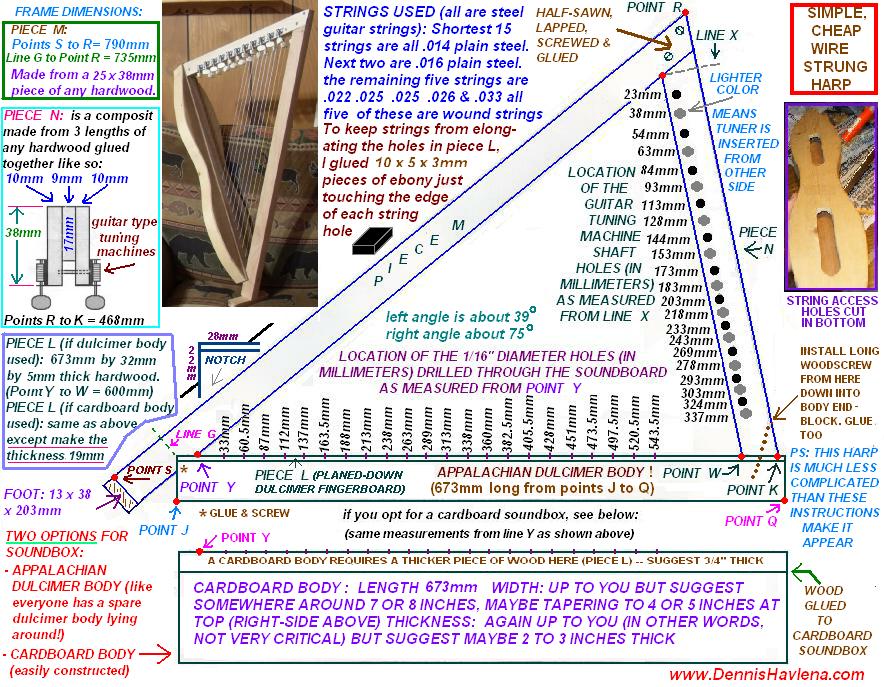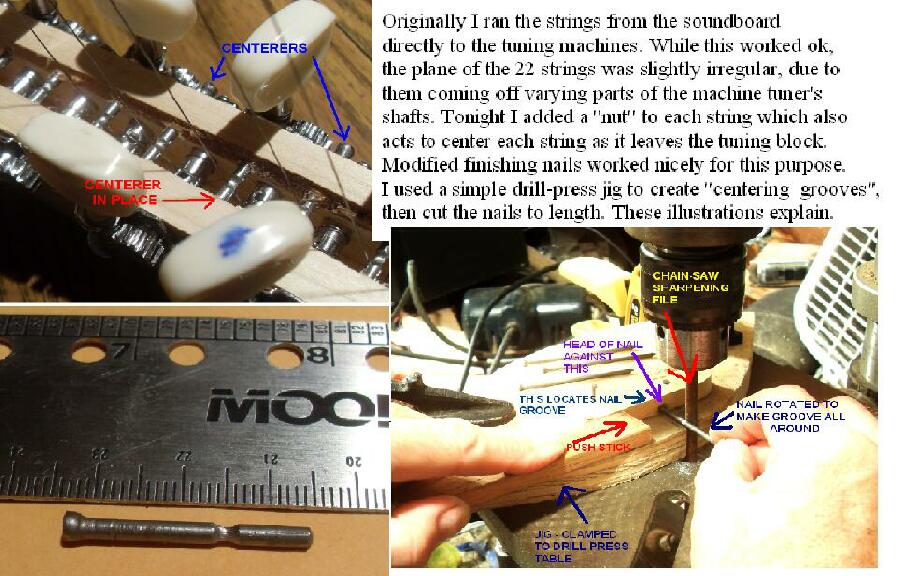
Click here to access
my webpage

CLICK
HERE to see a short YouTube video of this instrument
Both versions use wire guitar strings. I first tried monofilament nylon,
but with the relatively small soundbox there wasn't much volume, whereas
with the metal strings, it's much louder.
Instead of conventional tuning-pins, I used 22 regular guitar tuning machines
(which cost about two bucks apiece from elderly.com )
These were by far the biggest expense.
Pro: don't have to resort to using a tuning wrench.
Con: the harp is noticably heavier than with tuning pins - not a problem tho.
Also, they cost more.
The frame for the harp is scrap hardwood obtained from Habitat for Humanity's
local Re-store for about a buck a strip. My first harp's frame was made from
Tulip Poplar, Rock Maple and Black Walnut. Any hardwood will work fine.
Construction is very straightforward. The illustrations and measurements
should be sufficient.
Making a cardboard soundbox for this harp is very simple and easy.
Likely an hour-long project. Regular shipping-box type corrugated cardboard is
cut into the shape and size of your choice (very non-critical) then Elmer or
Tite-bond glued together. Cut string-access holes in the bottom as per above
illustration. Also, somewhere around 1/2 inch diameter holes should be cut
into the box's top, centered on where the string ends go through the bottom
frame member (Piece L). Altho not really necessary, you could glue 1/4 inch
"quarter-round" wooden molding on all inside seams where one piece of cardboard
meets the other. Furniture stores are good sources of unwanted cardboard.
The soundbox can also obviously be made from wood. 1/8" thick plywood salvaged
from old interior house doors (Habitat for Humanity etc) would make a great
soundbox. I'd use this plywood for the entire thing - just glue in the
above-mentioned "quarter-round" molding. If you opted for this, the lower frame
member ("Piece L") could be made the same thickness as for the "dulcimer-soundbox"
instrument -- the wooden body would easily withstand the tension.
I might say that I found surplus surgical hemostat-forceps to be almost a
necessity when stringing this thing -- there are a "few" tight spots that the
hemostat is the tool for. These things are good for all sorts of other
musical instrument-building applications from setting fiddle soundposts
to reaching into places that pliers, even needle-nose pliers, might find
difficult or impossible.
The range of this harp is from C, an octave below piano's "middle C" to the
C note, two octaves above "middle C".
Despite the fact that with guitar-type tuning gears you have to tune a scale on
this thing by alternating left-right-left-right-left-right-left-right (C-D-E-F-G-A-B-C
etc), it's not hard to tune the instrument. Here's the easiest way
(tune one octave at a time):
- tune the lowest C note, then skip a string & tune the E then the G and then the B.
(the tuners for C,E,G & B are all on the same side of the instrument).
- now go to the right side & tune the lowest D, skip a string & tune F, then A, then C
- tweak first octave tuning. Then proceed to the next octave (C to C) the same way as above.
- repeat for the third octave.
New strings take some time to settle down as does the instrument itself. After about a
week I found things pretty well settled. In any event, wire strings start to behave
(stay in tune) far faster than nylon strings.
The thing uses only 7 different gauges of steel guitar strings, the shortest 15 being
inexpensive .014 guitar E (or B) strings. In several cases you can get more than one
of the higher-pitched strings out of a single guitar string. I collect old discarded
strings from friends & my cost here for strings was nil. I cut 1/2" lengths of thin
finishing nails to use as "toggles" that keep the strings (looped around & secured to
the toggles) from slipping through the soundboard holes.
A bit later PS (a somewhat un-necessary improvement) ---
This makes the instrument a little harder to build and is not really needed on such a
simple instrument, but it does serve to align all 22 strings in a nice, flat plane.
The grooves in the nails can be hand filed as well:

Dennis Havlena Webpage at www.DennisHavlena.com